

Instructional Design Information. Sign In. 150 Amazing and Free Resources for ELearning Professionals. ELearning Courses development requires time and money, but there are dozens of free resources developed to minimize your efforts and create efficient and well-designed eLearning courses.
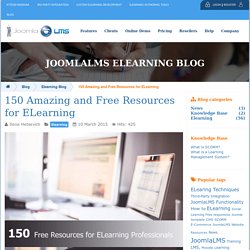
Based on our experience in the eLearning, marketing and management fields we compiled a list of useful tools and online resources to use in eLearning courses design and development. Time Management ELearning specialists frequently work remotely and know the value of time like no one else. For those who tear between unfinished projects and impatient clients there are free online tools for time management: When there are too many things on the agenda and time presses, take advantage of free online services and tools for productivity and self-organization. The fact that visual information is processed by our brain 60 000 times faster than ordinary text leads to all-round usage of visual content in eLearning design. The Best of Breed Learning Tools 2014.
The 3 Essential Questions Every Learner Wants Answered. Those who design elearning courses are the bridge between the client who has specific expectations and the learner who has to take the course.
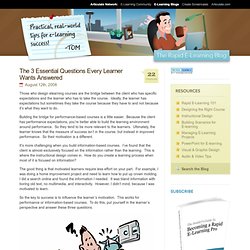
Ideally, the learner has expectations but sometimes they take the course because they have to and not because it’s what they want to do. Building the bridge for performance-based courses is a little easier. Because the client has performance expectations, you’re better able to build the learning environment around performance. So they tend to be more relevant to the learners. Ultimately, the learner knows that the measure of success isn’t in the course, but instead in improved performance. It’s more challenging when you build information-based courses. The good thing is that motivated learners require less effort on your part. So the key to success is to influence the learner’s motivation. 70:20:10 - Seize the seventy. As you know, 70% of learning happens while we're working.
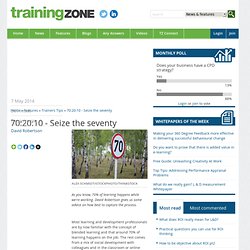
David Robertson gives us some advice on how best to capture the process. Most learning and development professionals are by now familiar with the concept of blended learning and that around 70% of learning happens on the job. The rest comes from a mix of social development with colleagues and in the classroom or online training courses. Whilst the concept may be relatively easy to grasp, actually implementing a sustainable learning system that enables staff to learn on the job can be much harder.
What the 70% tells us is that learning is a continuous process that never stops. Ideally, only 10% of learning and development's budget, time and resource should be spent on one-off learning sessions that equip employees with new skills. It should consist of processes, tools, metrics and support to help learners get on the learning path and stay on it. Finally, measure behaviour change. Word to HTML Tutorial. The Modern L&D Dept requires other skills than instructional design.
Instructional Design is for designing instruction.
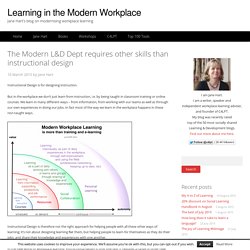
But in the workplace we don’t just learn from instruction, i.e. by being taught in classroom training or online courses. We learn in many different ways – from information, from working with our teams as well as through our own experiences in doing our jobs. In fact most of the way we learn in the workplace happens in these non-taught ways. Instructional Design is therefore not the right approach for helping people with all these other ways of learning; it’s not about designing learning for them, but helping people to learn for themselves as they do their jobs, and share their knowledge and experiences with one another.
Instructional Objectives Builder. Skip to Content Teach Online9 Learning Objectives Builder Use the ASU Online Objectives Builder tool below to write measurable course outcomes and learning objectives.
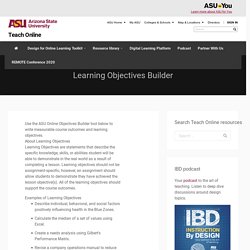
About Learning Objectives Learning Objectives are statements that describe the specific knowledge, skills, or abilities student will be able to demonstrate in the real world as a result of completing a lesson. Examples of Learning Objectives Describe individual, behavioral, and social factors positively influencing health in the Blue Zones.Calculate the median of a set of values using Excel.Create a needs analysis using Gilbert’s Performance Matrix.Revise a company operations manual to reduce energy consumption.Diagram the main constructs of social cognitive theory.Summarize the scope and source of food waste in the United States. Objectives Builder Tool. Gray Harriman Index. Instructor Led Training…Is It Still the Gold Standard?
By Bryant Nielson, Managing Director On October 30, 2014 Under eLearning, Featured Posts, Learning & Development, MOOC, Training In the training world, we often refer to instructor-led-training (ILT) as the gold standard.

We compare every other form of training to it and seek to replicate it as closely as possible when developing new training methodologies. But it recently occurred to me that the underlying assumption here might not be correct, and that ILT might not be the ultimate high-value training after all. Digital learning environments like massive open online courses (MOOCs) are starting to challenge the preeminence of ILT. Is it time we had a new gold standard? Why is instructor-led training considered the best? ILT became the gold standard not because it’s perfect (we all know that isn’t true), but because it’s better than other traditional methods of training.
Webinar Ideas. eLearning Ideas. Training Evaluation. LMS Tools. Clip Art, etc.